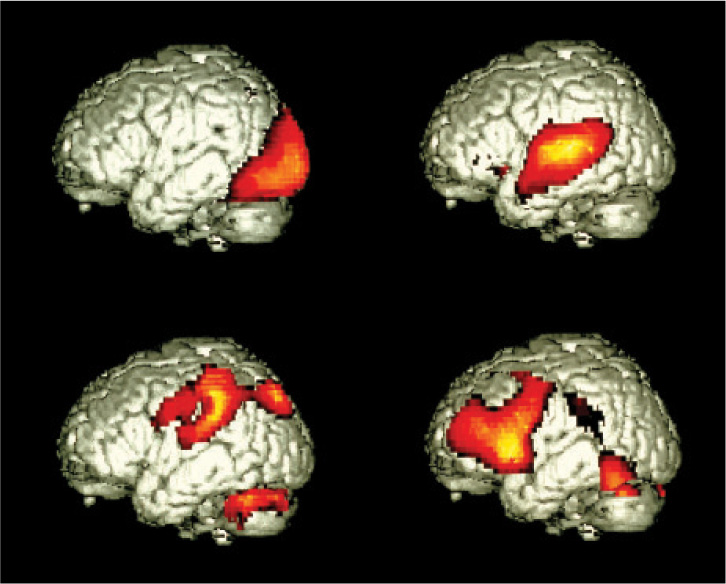36.6 MEMORY AND COGNITION
The ability of the brain to process and integrate complex sources of information, interpret and remember past events, solve problems, reason, and form ideas is broadly referred to as cognition. In this section, we consider memory and learning, as examples of cognitive abilities.
36.6.1 The brain serves an important role in memory and learning.
Memory is the basis for learning. An animal that can remember its encounter with a predator or noxious plant will avoid that danger in the future. A memory is formed by changes to neural circuits within specific regions of the brain—specifically, by changes in the synaptic connections between neurons in a neural circuit. These changes enable an animal, for example, to recognize other individuals in its social group or to recognize the threat of a predator. In humans and other primates, the hippocampus, a brain structure in the limbic region, plays a special role in memory formation. We can remember much of the information we receive for several minutes. However, unless reinforced by repetition or by paying particular attention, the information is typically forgotten. The hippocampus transforms reinforced short-term memories into long-term memories. Long-term memory is essential for learning.
The hippocampus forms long-term memories by repetitively relaying information to regions of the cerebral cortex. The molecular and cellular basis for memory and learning remains uncertain but depends on establishing particular neural circuits in the cortex. These circuits can be activated to recall a memory that is triggered by relevant stimuli. The formation of a memory circuit requires changes in synapses, which establish a particular set of connections between neurons in the circuit. Some synapses are weakened or removed altogether, and others are formed or strengthened to establish and refine the circuit.

The ability to adjust synaptic connections between neurons is called synaptic plasticity (Fig. 36.25). Long-term potentiation (LTP) is an example of synaptic plasticity that is believed to underlie memory and learning. In response to repeated excitation, neurons in excited circuits within the hippocampus release the neurotransmitter glutamate, opening Na+ and Ca2+ channels. The increased Ca2+ stimulates protein synthesis and signaling pathways that make the cells more responsive to subsequent stimulation. The release of glutamate stimulates the placement of new receptors in the postsynaptic cell membrane as well as the formation of new dendrites, strengthening synaptic signaling between the two cells.
Through repeated activation of neurons within the hippocampus and associated regions of the cerebral cortex, neural circuits are established that may be reinforced by LTP to create a memory that can be retrieved over long periods of time. Although memories may be associated with certain regions of the cortex, they also rely on the interaction of nerve cells and networks within multiple brain regions. Consequently, when a local brain region suffers damage, memories that are lost as a result may sometimes be recovered by reinforcement of the memory stored within other regions.
Although the brain regions involved in memory and learning vary among different animals, the basic features of how memories are constructed by means of synaptic plasticity within neural circuits are likely broadly shared across animals capable of forming memories. For example, the ability of an octopus to learn and remember how to perform motor tasks rivals that of certain vertebrates. Even the roundworm C. elegans has been found to be capable of memory and learning: Individual roundworms learn to avoid pathogenic bacteria in favor of bacteria that are nutritious.
Quick Check 5
Which three areas of the human brain are important for remembering and recognizing a face?
36.6.2 Cognition involves brain information processing and decision making.
Cognitive brain function ultimately gives rise to a state of consciousness—an awareness of oneself and one’s actions in relation to others. Consciousness allows judgments to be made about events and experiences in one’s environment. When you suddenly see someone you recognize from long ago, rapid neural associations within the cortex identify that person by name, retrieve multiple memories of past events you shared with that person, and elicit conscious thoughts, including your opinion of that person. At the same time, extraneous sensory information is filtered and other thoughts recede, allowing you to focus your attention on the person you have just seen and recognized.

Mental processes are studied by relating changes in brain activity to changes in an animal’s behavioral state. The study of the brain is made challenging by the complexity of the circuits involved. Nevertheless, considerable progress is being made through non-invasive neuroimaging techniques (Fig. 36.26). These techniques allow the interactions of different brain regions within human and other animal subjects to be investigated while the subjects perform a particular mental or motor task. The results of neuroimaging studies can be linked to studies of the molecular and cellular properties of nerve cells, to advance our understanding of how nerve cells form and maintain nerve cell circuits among different brain regions, and of how these circuits are linked to particular behaviors and cognitive processes.
Do animals other than humans have a conscious state of awareness? Although the conscious awareness of other animals is difficult to study, it seems clear that many animals exhibit conscious states of awareness that influence their experience and behavior. Donald Griffin, known for his co-discovery as an undergraduate of bat echolocation, advocated the view not only that animals are conscious, but also that animal consciousness is amenable to scientific study. Behavioral biologist Marion Dawkins summarized her review of studies on animal cognition and consciousness as follows:
Our near-certainty about [human] shared experiences is based, amongst other things, on a mixture of the complexity of their behavior, their ability to “think” intelligently and on their being able to demonstrate to us that they have a point of view in which what happens to them matters to them. We now know that these three attributes—complexity, thinking, and minding about the world—are also present in other species. The conclusion that they, too, are consciously aware is therefore compelling.